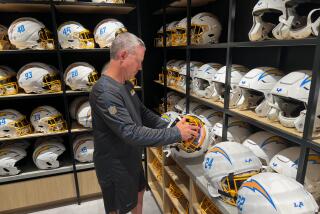Steroids ‘Rampant’ in Old NFL
- Share via
KAPALUA, Hawaii — Jim Haslett didn’t take steroids for vanity. He took them to survive in the NFL.
“If you didn’t, you weren’t as strong as everybody else, you weren’t as fast as everybody else,” said Haslett, 49, now coach of the New Orleans Saints and once a starting linebacker for the Buffalo Bills. “That’s the only reason to do it. Everybody’s looking for a competitive edge.”
In a rare confession by a former NFL player, Haslett said he took steroids for about six weeks early in his nine-year playing career but stopped because of the way they made him feel -- bloated and edgy. He also said that steroid use was “rampant” when he was playing, and he estimated that about half of the players in the league were using them -- among them “all the offensive and defensive linemen, linebackers.”
He talked about the experience Wednesday with a few reporters here at the NFC coaches’ breakfast, a traditional part of the four-day NFL meetings.
He took the performance-enhancing drugs 25 years ago, when steroid use in the league went unchecked. The NFL began testing for banned substances in 1987, although those tests were for informational purposes. The league began suspending players for steroid use in 1989, and a year later introduced random testing. In 1993, the policy was written into the collective-bargaining agreement with the NFL Players Assn.
As Major League Baseball grapples with its highly publicized steroid problem, which has included Congressional hearings, many people around the NFL argue their drug policy is the most comprehensive of any professional sports league.
Unlike baseball, which until this year allowed players multiple positive tests before suspensions were levied, the NFL doles out a four-game suspension for a first-time violator, a six-game suspension for a second positive test, and at least a one-season suspension for a third.
“I’m comfortable our steroid policy is very effective,” NFL Commissioner Paul Tagliabue said. “And no, I can’t say I’m comfortable with things not slipping through the cracks, because THG [human growth hormone] slipped through everyone’s cracks because it was not a known substance and there was no test for it. And now that there’s a test for it, we’re testing.
“I think we have a very strong program and very pervasive testing and very severe penalties and minimum number of violations. But is it perfect? No.”
Carolina Panther officials have acknowledged being subpoenaed by the Drug Enforcement Administration as part of an investigation into Dr. James M. Shortt, a West Columbia, S.C., physician who allegedly distributed steroids.
The State newspaper in Columbia, S.C., has reported that DEA agents sought to speak with at least nine current and former Panthers, some of whom were on Carolina’s Super Bowl team in February 2004. The paper, citing unnamed sources, said the DEA has audiotapes of discussions between Shortt and Panther players.
“Our security people are investigating that, and I know they’re cooperating closely with the Panthers,” Tagliabue said. “We’re getting good cooperation on both sides, and at some point they’re going to give me a report.”
Although Haslett didn’t name names, he gave specific examples.
“I was playing against a guy from Cleveland,” he said. “I’ll never forget 1979, the guy was a backup tight end, he weighed about 260. The next year he was their starting guard at 310.
“They tossed you around; they were strong. Everybody wanted an advantage, so you tried it. I tried it. Everybody tried it.”
Later, he said: “I played with a guy who came into the league, he came out of the [U.S. Football League], he was 270 and he would never have made our team if he didn’t get up to 300. The linemen got him together, got him a little supplemental pill for the week and he got up to about 305 and made our team and he’s probably one of the all-time great players in Bills history.”
After being drafted from Indiana University of Pennsylvania in the second round of the 1979 NFL draft by Buffalo, Haslett was voted Associated Press defensive rookie of the year. He played eight seasons with the Bills, earning All-Pro honors in 1981.
While acknowledging the dangers of steroids, Haslett said he increased his bench press by 40 pounds during the weeks he was using steroids and didn’t need as much recovery time between lifting sessions.
“You can lift like Monday, Tuesday, Wednesday, Thursday, Friday -- you never got tired,” he said. “Your muscles recovered from it. When you lift, your muscle tears down and the blood comes in and repairs it. It takes about 28 to 40 hours for the blood to repair the muscle. When you take steroids and it rips the muscle, the blood immediately flows in there and it repairs itself right away. That’s why you never feel tired, you never feel sore.”
He said he eventually began to worry about the long-term effects of the drugs and decided to quit taking them.
“I didn’t think it was very good for you,” he said. “I was hyper all the time. Got bloated, a fat face. If you didn’t eat right -- I’ll tell you one thing about steroids, if you take them you still have to eat right and you have to work your ... off. If you take them and you don’t do anything, that doesn’t do anything for you.
“Guys like these baseball players, they still work their ... off. It’s not like you just take them and you get strong, it doesn’t work that way.”
More to Read
Go beyond the scoreboard
Get the latest on L.A.'s teams in the daily Sports Report newsletter.
You may occasionally receive promotional content from the Los Angeles Times.











